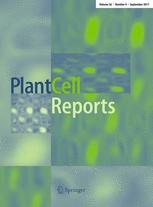Ver ítem
- xmlui.general.dspace_homeCentros e Institutos de InvestigaciónCICVyA. Centro de Investigación en Ciencias Veterinarias y AgronómicasInstituto de GenéticaArtículos científicosxmlui.ArtifactBrowser.ItemViewer.trail
- Inicio
- Centros e Institutos de Investigación
- CICVyA. Centro de Investigación en Ciencias Veterinarias y Agronómicas
- Instituto de Genética
- Artículos científicos
- Ver ítem
pBAR–H3.2, a native-optimized binary vector to bypass transgene silencing in alfalfa
Resumen
Alfalfa is the main forage worldwide due to its high biomass production, excellent nutritional qualities and adaptation to a wide range of environments (Singer et al. 2018). Besides, due to its ability to grow without nitrogen fertilizers derived from fossil fuels and conditions of long-duration perennial crop, alfalfa is a natural candidate for large production of renewable raw materials and vaccines at extremely low cost (Aguirreburualde et al. 2013;
[ver mas...]
Alfalfa is the main forage worldwide due to its high biomass production, excellent nutritional qualities and adaptation to a wide range of environments (Singer et al. 2018). Besides, due to its ability to grow without nitrogen fertilizers derived from fossil fuels and conditions of long-duration perennial crop, alfalfa is a natural candidate for large production of renewable raw materials and vaccines at extremely low cost (Aguirreburualde et al. 2013; Saruul et al. 2002). However, the potential impact of alfalfa in agroindustrial processes is limited by strong transgene silencing. In the absence of genetic tools to bypass this constraint, the identification of alfalfa events with suitable transgene expression for commercial uses (e.g., high expression of transgenic traits) requires the production and analysis of a large number (e.g., 2000–3000) of transgenic events (Barros et al. 2019; Jozefkowicz et al. 2018; McCaslin et al. 2002). Naturally, this is an expensive empirical approach restricted to projects with high budget.
[Cerrar]

Autor
Fuente
Plant Cell Reports 39 : 683–685 (2020)
Fecha
2020-03
Editorial
Springer
ISSN
0721-7714
1432-203X
1432-203X
Formato
pdf
Tipo de documento
artículo
Palabras Claves
Derechos de acceso
Restringido
 Excepto donde se diga explicitamente, este item se publica bajo la siguiente descripción: Creative Commons Attribution-NonCommercial-ShareAlike 2.5 Unported (CC BY-NC-SA 2.5)
Excepto donde se diga explicitamente, este item se publica bajo la siguiente descripción: Creative Commons Attribution-NonCommercial-ShareAlike 2.5 Unported (CC BY-NC-SA 2.5)

